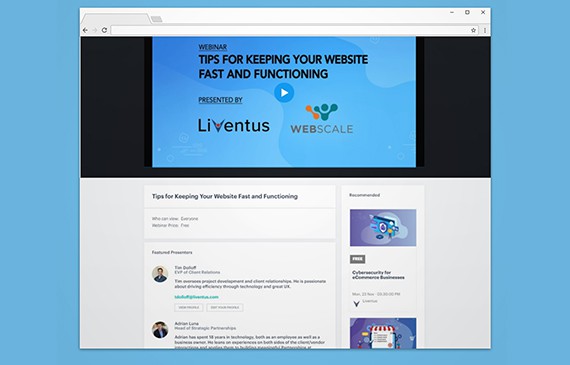Liventus is often tasked with improving eCommerce sites to make them dependable for when customers need them the most. In the past 25 years in building custom eCommerce solutions, I’ve helped companies navigate a variety of pain points in running a digital storefront. I sat down with Adrian Luna, Head of Strategic Partnerships at WebScale, to discuss some of the most important technological requirements that will keep websites fast, functioning, and ultimately sell more products.
Watch our latest webinar and our discussion with WebScale, the “Any Platform” Commerce Cloud Company, on how you can keep your site running:
How do you ensure your site has high availability?
Availability is the ability for your storefront to be accessed by customers on the internet. As your shoppers are using your site, its functionality becomes an important factor in whether or not they choose to buy.
- Customers need to easily navigate the site and have a positive user experience.
- Make sure your users can easily search for products.
What are three things that could threaten the availability of your site?
- A significant increase in website traffic and visitors.
- A security breach from someone with the intention of taking your storefront down.
- Your hosting provider has a sudden outage like a power failure or a connectivity problem.

What are some ways eCommerce stores can mitigate threats and give their site high availability?
- Choose a host provider that lives and breathes public cloud technology like WebScale, Amazon Web Services (AWS), Google Cloud, or Microsoft Azure.
- Keep your software code updated and patched.
- Work with a custom software company that gives you peace of mind and confidence your code is secure and managed properly.
What are some ways your site’s performance can plan for success?
- Prepare for website technical issues before they even exist.
- Define business goals and define user behavior.
- Put your site through a disaster performance test if your site has a sudden spike in web traffic.
- Pay attention to tools, like Google Analytics, to test and report on user behavior.
- See where code is loading slowly and make updates to the software when needed.
What are some other steps you can take to optimize the performance of an eCommerce site?
- Keep your code elegant and make sure any updates improve its user experience.
- Use CDN (Content Delivery Network) integration to minimize slow loading pages (introduce one if you don’t already).
- Be aware of your site’s ability to deliver content for different devices, such as tablets and different brands of phones, to quickly load images based on their hardware requirements.
- Make sure third-party services aren’t consuming resources and taking away from your site.
About This Webinar’s Attendees

Tim Dolloff was the speaker for this webinar. Tim has spent the past 25 years building custom software solutions, 15 of which were focused on the eCommerce industry. Tim founded a development firm in 2010 and sold it to Liventus in 2017. Joining Liventus at that time, Tim’s primary focus continues to be eCommerce development. His customers rely on him to be an expert and a problem solver, helping them unlock business potential by leveraging technology solutions. He has worked with clients in the apparel, health foods, jewelry, entertainment equipment, and live theatre (Broadway). He has been implementing websites on the Magento platform since it launched in 2007 (they are now owned by Adobe) but also has experience building completely custom websites and WordPress sites.


